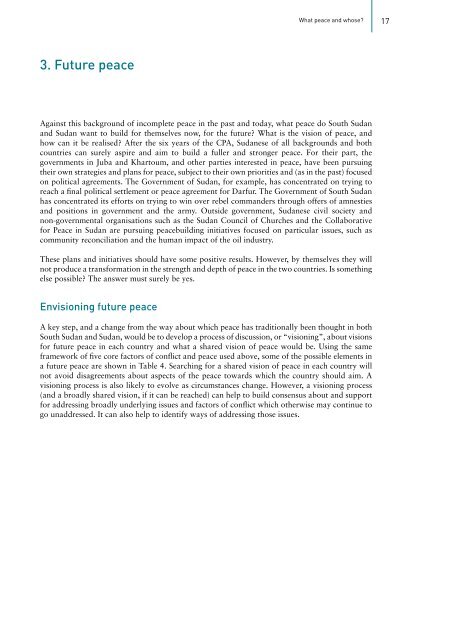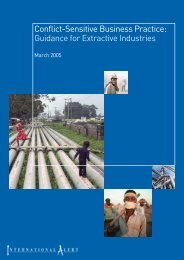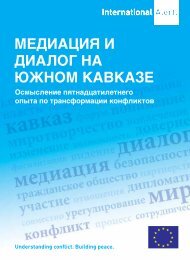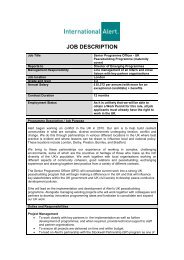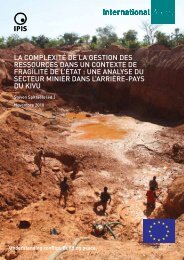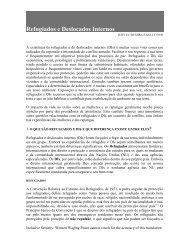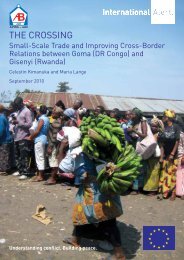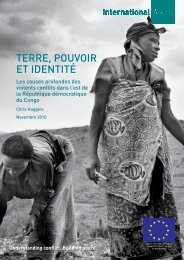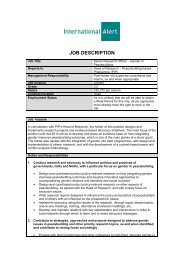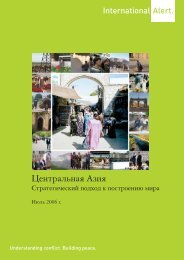What peace and Whose? - Internal Displacement Monitoring Centre
What peace and Whose? - Internal Displacement Monitoring Centre
What peace and Whose? - Internal Displacement Monitoring Centre
You also want an ePaper? Increase the reach of your titles
YUMPU automatically turns print PDFs into web optimized ePapers that Google loves.
<strong>What</strong> <strong>peace</strong> <strong>and</strong> whose?173. Future <strong>peace</strong>Against this background of incomplete <strong>peace</strong> in the past <strong>and</strong> today, what <strong>peace</strong> do South Sudan<strong>and</strong> Sudan want to build for themselves now, for the future? <strong>What</strong> is the vision of <strong>peace</strong>, <strong>and</strong>how can it be realised? After the six years of the CPA, Sudanese of all backgrounds <strong>and</strong> bothcountries can surely aspire <strong>and</strong> aim to build a fuller <strong>and</strong> stronger <strong>peace</strong>. For their part, thegovernments in Juba <strong>and</strong> Khartoum, <strong>and</strong> other parties interested in <strong>peace</strong>, have been pursuingtheir own strategies <strong>and</strong> plans for <strong>peace</strong>, subject to their own priorities <strong>and</strong> (as in the past) focusedon political agreements. The Government of Sudan, for example, has concentrated on trying toreach a final political settlement or <strong>peace</strong> agreement for Darfur. The Government of South Sudanhas concentrated its efforts on trying to win over rebel comm<strong>and</strong>ers through offers of amnesties<strong>and</strong> positions in government <strong>and</strong> the army. Outside government, Sudanese civil society <strong>and</strong>non-governmental organisations such as the Sudan Council of Churches <strong>and</strong> the Collaborativefor Peace in Sudan are pursuing <strong>peace</strong>building initiatives focused on particular issues, such ascommunity reconciliation <strong>and</strong> the human impact of the oil industry.These plans <strong>and</strong> initiatives should have some positive results. However, by themselves they willnot produce a transformation in the strength <strong>and</strong> depth of <strong>peace</strong> in the two countries. Is somethingelse possible? The answer must surely be yes.Envisioning future <strong>peace</strong>A key step, <strong>and</strong> a change from the way about which <strong>peace</strong> has traditionally been thought in bothSouth Sudan <strong>and</strong> Sudan, would be to develop a process of discussion, or “visioning”, about visionsfor future <strong>peace</strong> in each country <strong>and</strong> what a shared vision of <strong>peace</strong> would be. Using the sameframework of five core factors of conflict <strong>and</strong> <strong>peace</strong> used above, some of the possible elements ina future <strong>peace</strong> are shown in Table 4. Searching for a shared vision of <strong>peace</strong> in each country willnot avoid disagreements about aspects of the <strong>peace</strong> towards which the country should aim. Avisioning process is also likely to evolve as circumstances change. However, a visioning process(<strong>and</strong> a broadly shared vision, if it can be reached) can help to build consensus about <strong>and</strong> supportfor addressing broadly underlying issues <strong>and</strong> factors of conflict which otherwise may continue togo unaddressed. It can also help to identify ways of addressing those issues.


